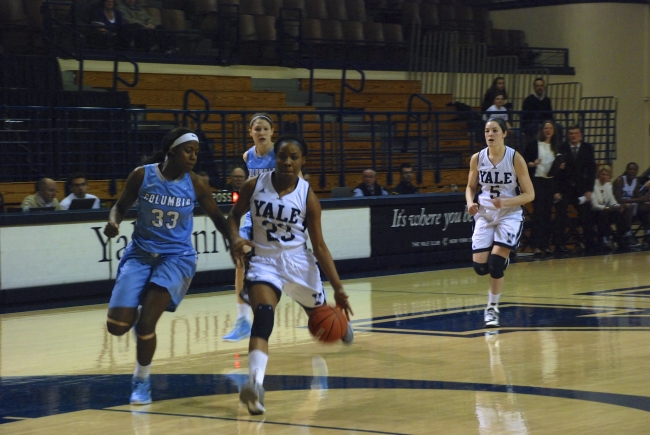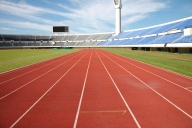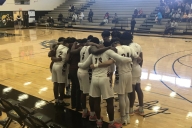You have /5 articles left.
Sign up for a free account or log in.

Yale's women's basketball team competes against Columbia.
kkimphotography | Flickr
Starting next season, the Ivy League will further limit time demands on college athletes, enacting a pair of new rules similar to those the National Collegiate Athletic Association’s wealthiest conferences failed to adopt earlier this year.
The new rules will give athletes a 10-hour window of no official athletic activity following their return from a road trip and will require a two-week recovery period with no allowable team athletic activities following the completion of a team’s season. The two proposals were passed by the league’s athletics directors in May before being adopted by the conference’s presidents this month.
“We have a long history of regulating time demands beyond what the NCAA requires, and we’ve been paying attention to the conversation about these issues the past couple of years,” said Robin Harris, executive director of the Ivy League. “Our athletic directors just asked themselves, ‘Why can’t we just do this?’ The answer was, ‘Of course we can do this.’ We hope that it shows that this is not that hard.”
The Ivy League -- whose members include Brown, Columbia, Cornell, Harvard, Princeton and Yale Universities, Dartmouth College, and the University of Pennsylvania -- has long beaten the NCAA to the punch on issues of athlete welfare in Division I, the associations' most competitive level.
In March, the league banned tackling during football practices over worries about brain injuries received by players. One of its members, Dartmouth, had already banned full-contact practices in 2010, and the following year, the league reduced the number of such practices the university could hold. The NCAA does not have rules on how many full-contact practices football teams may have, though its guidelines recommend allowing no more than two per week during the season and no more than four during the preseason.
Many conferences in Division I athletics continue to admit athletes through special admissions processes that can lead to some athletes having SAT scores as much as 400 points lower than that of the average freshman. Since 1985, Ivy League institutions have used an academic index, which consists of SAT scores and grade point averages, to require that athletes fall within certain standard deviations -- often about 12 to 16 points -- of the general student body.
The Ivy League is the only Division I conference that does not offer sports scholarships. When the Patriot League was formed in 1986, its founding members -- Bucknell, Colgate and Lehigh Universities, College of the Holy Cross, and Lafayette College -- agreed to not offer such scholarships. But in 2012, that league, too, began awarding athletics scholarships in all of its sports.
“Historically, the Ivies were the first to move away from the big-time college sport environment when they ‘disarmed’ in the late 1950s,” Mark Nagel, professor of sports and entertainment management at the University of South Carolina, said. “They have also tried to keep a closer athletic-academic entrance requirement so that the athletes are more closely aligned with the rest of the campus as far as entrance test scores. Most other schools did not follow their lead but instead upped the ante on their college sport expenditures in the 1960s and beyond.”
At the NCAA’s annual meeting in January, the five wealthiest athletic leagues, known as the Power Five conferences, were set to vote on legislation that would limit time demands. The Ivy League consulted with the Power Five ahead of the vote, Harris said, and had hoped that the leagues would adopt the new rules.
Hours before the conferences were expected to vote on the proposals, they decided to table the legislation until next year. The move frustrated many of the athletes in attendance, as well as the Pac-12 Conference, which had proposed the new rules.
“We’re on the side of wanting to be bold, of wanting to be very progressive, and we’re going to continue to be very aggressive about these things that benefit our student-athletes,” Larry Scott, the Pac-12’s commissioner, said at the time. “There clearly were some who wanted more time to digest it, to understand the implications. There’s no question that the things we put forward are going to be voted on in the following year. But I am frustrated.”
One of the tabled proposals would have created a three-week discretionary period following the championship segment of a season. Another proposal aimed to prohibit athletically related activities, other than competition, for a continuous eight-hour period between 9 p.m. and 6 a.m.
The results of a national survey of 30,000 Division I athletes, released by the NCAA in January, found that many athletes want to spend less time on athletics. More than 40 percent of football and basketball players said they wanted an additional day off per week beyond the one they have now, and most athletes indicated they would appreciate two weeks off at the end of a season.
According to data also released by the NCAA at the convention in January, as part of its ongoing GOALS study, football players in the Football Bowl Subdivision -- the association’s most competitive level -- report spending 42 hours per week on their sport. Two-thirds of Division I athletes reported spending as much or more time on athletics during the offseason as during the season. Nearly one in three FBS football players said their sport prevented them from enrolling in a course they wanted to take.
Soccer players, swimmers and divers reported spending the least amount of time on their sports, though at 29 hours, even they still surpassed the amount of required athletic activity allowed by the NCAA. Subsequent NCAA surveys have shown even more support among both athletes and coaches for lessening time demands.
Leaders within the Power Five conferences said they want to see more research on the issue before taking any action. Harris said there was already enough research for the Ivy League to act. Other rule changes related to time demands are now also being discussed, she said.
“Frankly, other conferences were not working together to pass this legislation in an efficient manner,” Harris said. “So doing this was really out of frustration that this process was going to take too long. It would be terrific if other conferences adopted these rules, too.”








